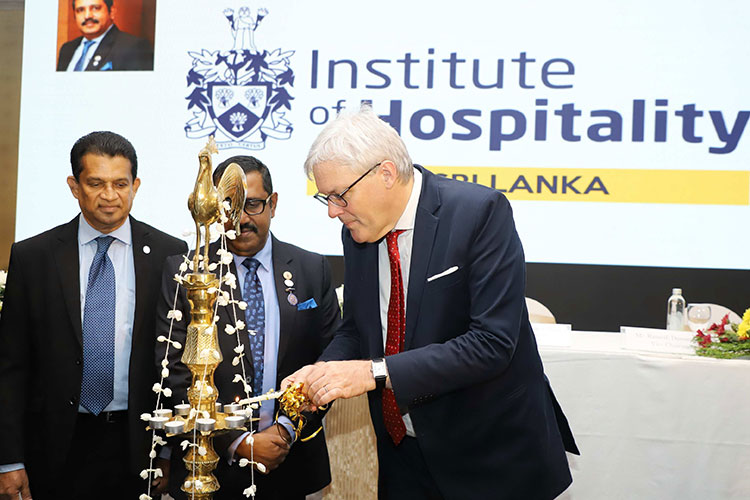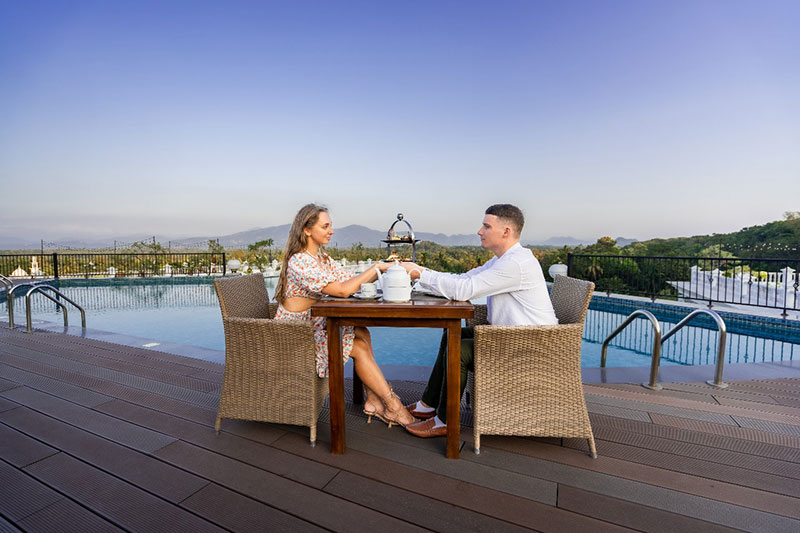Life style
King of Noodles
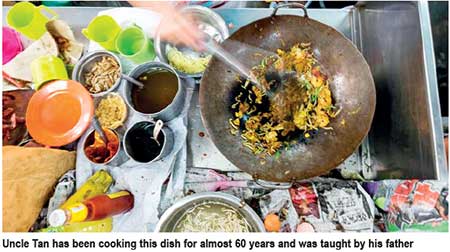
Food-loving Malaysians have been known to debate the best local food spots for hours. Tan Chooi Hong, hunched over a blazing hot wok, hadn’t broken a sweat. Flames from the charcoal sparked and danced up the side of the wok, crackling as he added the ingredients one by one, just as his father taught him almost 60 years ago. Char kway teow, Malaysia’s most famous street food, is a simple rice noodle dish made with soy sauce, eggs, cockles, bean sprouts, Chinese sausage and a couple of shrimp. It’s common throughout the country – devoured at roadside stalls or feasted on at hawker centres – but there is only one “king” of char kway teow, and he’s in Penang. Uncle Tan, as he’s known, is a sturdy 79-year-old with a shock of white hair and an all-knowing glimmer in his eye. He’s been cooking this single dish from a wok-cart attached to a bicycle and pushed into place on the side of Siam Road in central George Town for decades. “I don’t remember how old I was when I started. But char kway teow is all I know,” said Uncle Tan.
Uncle Tan’s unlikely fame began in 2012 when he was interviewed by a local who put the story on Facebook. His decades of cooking experience, combined with layered flavours of smoky-unctuous noodles perfectly balanced with the salty-sweet Chinese sausage, quickly got the younger generation of foodies salivating. Nothing is better than a simple noodle dish with an interesting backstory, and young Penangites ate it up. The article went viral and people began flying to the island just to taste his dish.
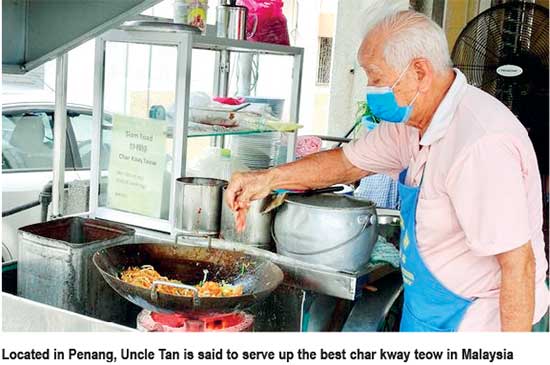 In 2015, celebrity chef Martin Yan, known for his Yan Can Cook TV show, visited the stall for his TV show Taste of Malaysia. If that fame didn’t cement Uncle Tan’s title as king, placing 14th (out of 50) at the World Street Food Congress in 2017 certainly did. Today, his roadside wok-cart is a fixture in the food scene and he’s widely revered as serving up the most delicious, flavoursome char kway teow in Malaysia, churning out hundreds of plates a day with people waiting in line for hours.
In 2015, celebrity chef Martin Yan, known for his Yan Can Cook TV show, visited the stall for his TV show Taste of Malaysia. If that fame didn’t cement Uncle Tan’s title as king, placing 14th (out of 50) at the World Street Food Congress in 2017 certainly did. Today, his roadside wok-cart is a fixture in the food scene and he’s widely revered as serving up the most delicious, flavoursome char kway teow in Malaysia, churning out hundreds of plates a day with people waiting in line for hours.
Uncle Tan is unfazed by his fame and prefers to keep a low profile. Humble and shy, he can’t understand what all the fuss is about and doesn’t think his version is any better than anoyone else’s.
“My dad didn’t go to school to learn any skills. It wasn’t an option. He had to work for his father, so he worked by his side cooking char kway teow every day,” his daughter, Tan Evelyn, told . “And he’s never stopped.”
The ingredients of char kway teow are so simple that it takes a lot of skill to get it right. The main ingredient is flat rice noodles. No self-respecting char kway teow stall would use dried noodles, so Uncle Tan gets bags of the fresh, chewy goodness delivered by scooter regularly.
I watched as he skillfully added one ingredient at a time, just by feel and sight. He threw a large handful of slippery noodles in the blisteringly hot wok and used a wide metal spatula to spin them around in the garlic and lard waiting for them. After pushing the noodles up the side of the pan, he expertly cracked an egg into the middle, breaking it with the spatula to let the yolk ooze into the noodles.
A few soy sauce dashes, a spoonful of chilli sauce and a little water created a silky sauce that the noodles absorbed. Then Uncle Tan tossed in a couple of shrimp and a few slices of sweet lap cheong, or Chinese sausage. Finally, a smattering of cockles got a spin in the wok. He topped it all with a handful of crunchy bean sprouts, chives and small homemade croutons made of crispy pork fat.
He eyed the steaming noodles for the perfect consistency and then scooped them onto a melamine plate and started all over again. The whole process was lightning fast – less than two minutes – and Uncle Tan made it look effortless.
While many stalls use gas, Uncle Tan cooks on charcoal, frying one order at a time for maximum flavour and wok hei, which translates to “breath of the wok”. Wok hei is the smoky depth of flavour that charcoal adds to the dish and is expertly created by cooking the right portion over the right temperature. It’s something that gas heat cannot achieve.
Some people say that charcoal is the secret to Uncle Tan’s success, but, “they like my father’s char kway teow better than others because he’s perfected it over 60 years,” said Evelyn. “Other stalls use charcoal and the same ingredients, but no-one has his skill. Not even my brother Kean Huat who learned from him.”
Others try to attribute Uncle’s success to a secret sauce. “I promise. There is no secret sauce; it’s his wok skill,” said Evelyn. “I also cannot fry as my brother or dad. My brother has been working for years learning from my dad, and his skills are still improving. It takes a lifetime. Just ask my dad.”
“If I give you the same ingredients, you cannot make the same taste as me,” agreed Uncle Tan.
Even though char kway teow has become synonymous with Penang street food, its origins lie in China. In the 19th Century, the Chinese diaspora brought over Teochew and Hokkien people from Guangdong and Fujian provinces on China’s south-eastern coast. During that same time, Penang grew under British rule and it became a bustling entrepot providing greater employment opportunites. The Hokkien people came to work in the rubber plantations and as traders and merchants, while the Teochew found jobs in the tin mines and as fisherman. With them came some of their kitchen staples like soy sauce, bean curd and noodles called kway teow.
In Hokkien, the word char means “stir-fried”, and kway teow means “rice cake strips”, referring to the noodles. What had begun in China’s south-eastern provinces as a simple noodle dish with pork, fish sauce and soy sauce was transformed into a seafood delight once it hit the island’s shores. Initially, it was sold at night by fisherman and cockle gatherers trying to make an extra buck. Instead of the traditional ingredients, they used what was plentiful to create a revised version of the dish. It was a poor man’s food and the other Chinese immigrants devoured it as something fast, cheap and tasty to sustain them for hours under the hot sun. The dish became a labourer’s staple.
“When the waves of Teochew and Hokkien immigrants came from China, they came alone, leaving their wives and families behind. Since there was no-one to cook for them, they survived on cheap street food,” said Nazlina Hussin, a Penangite culinary specialist and author. “From wok to plate, char kway teow takes no time. These men could stop for lunch, eat and be back to work within a few minutes.”
To this day, most of the Chinese in Penang are of Hokkien and Teochew descent. It’s the only place in Malaysia where Hokkien is commonly spoken, which is why char kway teow has remained so closely linked to Penang. And although you can find the dish outside of Penang, locals say it’s not as good unless a Hokkien or Teochew makes it. That’s why people fly here from Kuala Lumpur and Singapore and wait in line for hours, in the hot sun, to try Uncle Tan’s char kway teow.
It’s that good.
Plus, he’s one of the oldest char kway teow legends in Malaysia. There is a reverence in that. “Most customers come here for my dad. People say he’s a char kway teow idol. So, if he’s not cooking, they keep on driving,” said Evelyn.
In 2018, for the first time in nearly 60 years, Uncle Tan took a break. On doctor’s orders after cataract surgery, he closed his shop for six months, and his devotees, like those of any idol or guru, went berserk. The whole island almost had a breakdown, with stories in local media lamenting his sudden overnight retirement. “Today we’ve had to endure the greatest loss of mankind,” wrote culinary website Penang Foodie. “Siam Road Char Koay Teow is believed to be closed down for go
Uncle Tan’s son took over for a brief moment and locals weren’t kind to him; Penangites are loyal foodies and they wanted the master’s char kway teow. After six months of ever-more grandiose gossip, “We had to find a place; we couldn’t let the people down,” declared Evelyn. Instead of going back to his original roadside spot, they decided to find a premises on the same street. Today Uncle Tan still cooks from a bike pushcart with a wok attached; it’s just parked in front of his shop.
He’s widely revered as serving up the most delicious, flavoursome char kway teow in Malaysia
“Now, my son and I can take turns cooking. When I get tired, I can sit down and watch Kean Huat try to perfect my dish,” he said with a wink. “It isn’t easy. But he’s a third-generation char kway teow cook, and even though he didn’t start as young as I did, he’ll be able to perfect his skills one day too.”
Uncle Tan’s char kway teow is not only Penang’s history on a plate; it’s his family’s history as well. Hopefully, Kean Huat will live up to his father’s reputation and teach future generations how to follow in the king’s footsteps.
But until then, “I have no plans to retire. As long as I can still stand and cook over the wok, I’ll be here on Jalan Siam,” laughed Uncle Tan.–BBC
Life style
Camaraderie,reflection and achievements

Institute of Hospitality Sri Lanka
 The 32nd Annual General Meeting (AGM) of the UK-based Institute of Hospitality’s Sri Lanka Chapter was held recently at the Ramada Hotel Colombo,.The event provided an evening of camaraderie , reflection of the past and present achievements,setting new benchmarks for the future
The 32nd Annual General Meeting (AGM) of the UK-based Institute of Hospitality’s Sri Lanka Chapter was held recently at the Ramada Hotel Colombo,.The event provided an evening of camaraderie , reflection of the past and present achievements,setting new benchmarks for the future
The AGM had the presence of two distinguished guests, the Chief Guest Opposition Leader Sajith Premadasa, and the Guest of Honour British High Commissioner to Sri Lanka, Andrew Patrick. Their inspiring speeches were lauded by all hoteliers who were present at the occasion
A special thanks was extended to Robert Richardson, CEO of the Institute of Hospitality UK, along with his team, sponsors, committee members, and all attendees for making the event memorable.
Dr. Harsha Jayasingh, Past President of the Institute of Hospitality (UK) Sri Lanka Chapter, emphasised the Institute’s longstanding history and the strength of its Sri Lankan branch. “The Institute of Hospitality (IH) UK has a history of 86 years, and we are proud to be the Sri Lanka Branch. IH Sri Lanka is much stronger now with many members from all areas of the hospitality industry,” he stated.
Dr. Jayasingh highlighted the significant role of tourism in Sri Lanka’s economy,. He said tourism it is the third-largest source of revenue for the country. “Tourism accounts for about 13.3% of total foreign exchange earnings and employs 450,000 people directly and indirectly. The hospitality industry in this island of pearl holds tremendous potential for economic growth, job creations, and cultural exchange,” he added.
He also pointed out more women should be attracted to the industry and advocated for the use of technology in hospitality sector to attract the younger generation.
The newly appointed Chairman Ramesh Dassanayake spoke about the challenges faced by the industry, including the reluctance of youth to join the sector. . Dassanayake expressed concerns over the migration of staff between hotels and the overall ‘brain drain’ in the sector. ” We must maintain high standards in the hotel We must try to attract tourists to Sri Lanka, we must have with many facilities Hence, hotel schools and other professional institutions involved in skills development mustincrease their intakes,” he pointed out.
Chief Guest Sajith Premadasa emphasised the importance of eco tourism and said “We need to have an environmental policy related to tourism in place,” . .
The 32nd AGM of the Institute of Hospitality UK, Sri Lanka Chapter, was a testament to the strength and potential of Sri Lanka’s hospitality industry. The insights and commitments shared during the event set a new benchmark for the future.(ZC)
Pix by Thushara Attapathu
Life style
He recognizes human identity beyond boundaries of gender, race, nationality and religion.
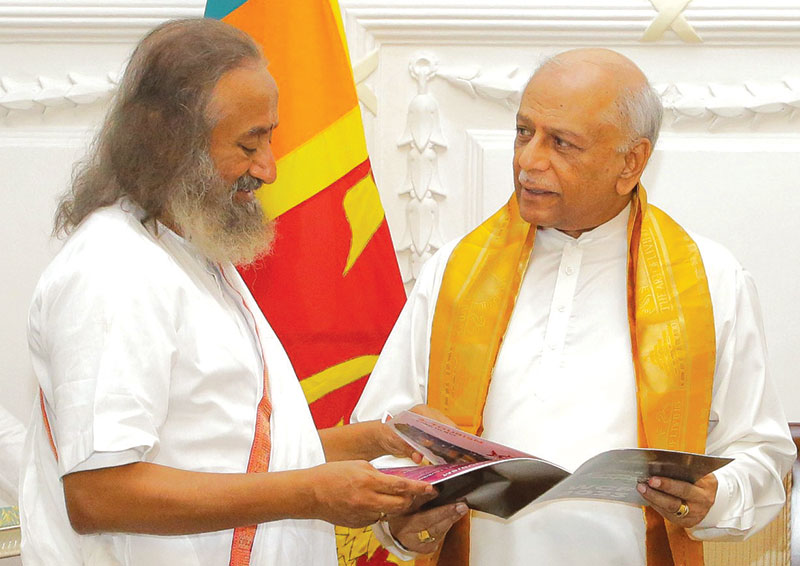
Visit of Sri Gurudev to Sri Lanka
Humanitarian, spiritual leader and Global Ambassador of Peace Gurudev Sri Sri Ravi Shankar (Sri Gurudev) was in Sri Lanka on a three day tour on the invitation of the Prime Minister of Sri Lanka Dinesh Gunewardene. Gurudev who inspired a wave of volunteerism and service to moot one of the largest volunteer-based organisations in the world – The Art of Living – visited the various projects under the aegis of the foundation and launched twelve vocational and technical centers around the island. He was accompanied by thousands of followers from Sri Lanka and around the world.
Gurudev who visited Sri Lanka for the sixth time also had a first day cover launched in honour of his visit. He is a strong proponent of spreading happiness, using the unique Sudarshan Kriya, yoga, meditation and practical wisdom to unite people, empower individuals and transform communities. His programmes provide techniques and tools to live a deeper, more joyous life, while his non-profit organisations recognize the human identity beyond the boundaries of gender, race, nationality and religion.
The Art of Living which has more than 30,000 teachers and over one million volunteers across 180 countries has touched in excess of five hundred million people around the world. CNN called it “Life Changing” and The Washington Post headlined it, “Fresh air to millions”.
In Trincomalee, Gurudev met with war victims and had a heartwarming engagement with the children from the children’s homes run by the Foundation. He also visited the Koneswara Temple in Trincomalee and graced the Kumbhabhishekam at Seetha ecogPnize the human identity beyond the boundaries of gender, race, nationality and religion. Amman temple at Nuwara Eliya. He held discussions with the trustees on the progress of the foundation’s social service projects, while also holding a special event – Ekamuthuwa – attended by a large number of dignitaries and his devotees from around the world.
His time with the Prime Minister was spent discussing the prospects of unity in diversity and uniting Sri Lanka by adding happiness into the formula of living. In addition he had discussions with the Speaker of the Parliament of Sri Lanka Mahinda Yapa Abeywardena, prominent business stewards and civil society leaders.
Life style
Bridal shows with opulence and luxury at The Epitome hotel in Kurunegala
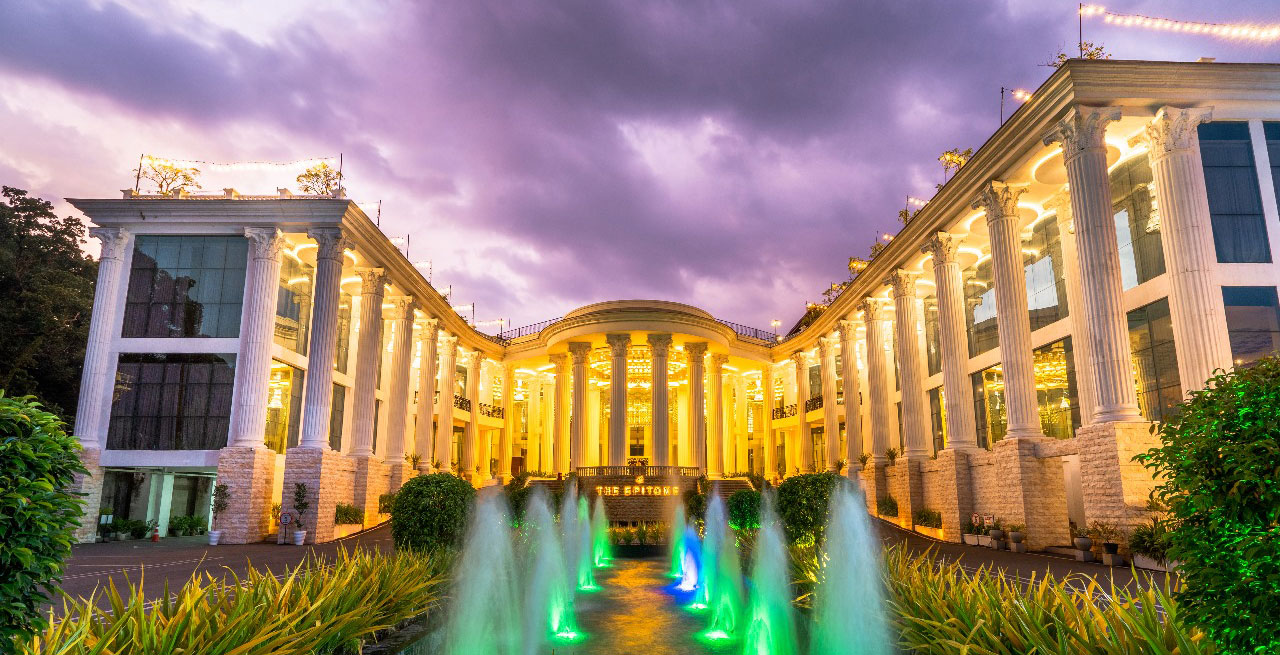
by Zanita Careem
Envison your dream wedding day come to life at the Epitome Hotel, a prestigious city hotel in Kurunegala offering an unrivalled luxury rendors experience for weddings.
The venue is designed to embody opulence and luxury from all quarters for a spectacular wedding in kurunegala,Thier ballroom is the largest banquet facility in Sri Lanka It can be divided into six luxurious pillarless wedding halls on the ground floor and 25pax smaller banquet halls.
It can be easily named as a five star heaven in the heart of the city contributing to a myriad of immense experiences tailored to inspire and delight wedding experiences.
From opulent décor set up to exquisite table decor, lavish food, every detail is meticulously curated to spark your imagination and ignite creativity for a perfect wedding. The previous prestigious wedding shows season one and season two attracted large crowds
were unique events which gave the wedding vendors and potential clients had an opportunity to connect and interact with each other. Beyond being a showcase it was a chance for the wedding vendors to unite and contribute to the vibrancy of the wedding industry. The wedding show covered all area of the bridal industry providing a comprehensive variety of bridal supplies from Sri lanka and became the most popular bridal exhibitions in Kurunegala.This bridal exhibitions allowed brides and grooms to experience first hand the products and services available from suppliers in Sri Lanka
These wedding shows held at The Epitome created a benchmark and gave an opportunity for vendors to create connections to the utmost satisfaction said Harshan Lakshita Executive Director. of the magnificent Hotel
Our wedding shows featured experts and professionals in every field‘ It covered all areas of the bridal industry provided a comprehensive variety of bridal supplies from Sri lanka and became most popular bridal exhibition in this region.We are always open to everyone to join us at our wedding shows in the future. It is an opportunity to discover the incredible talent within our local wedding and bridal vendors to make meaningful relationships and plan thier special day at our breathtaking hotel The Epitome said General Manager Kavinda Caldera
The Epitome Hotel’s bridal show which will be held end of June will buzz with great ideas,advice and inspiration for all those who plan thier dream wedding
…….
The Hotel Epitome’s Wedding Season 3 will marked excellence, celebration and inspiration for those in the wedding industry. The exhibition halls will resonate with ideas on exquisite bridal wear to decor, florists , photography etc and showshowcase the rich tapestry of talent within the local wedding industry. .




